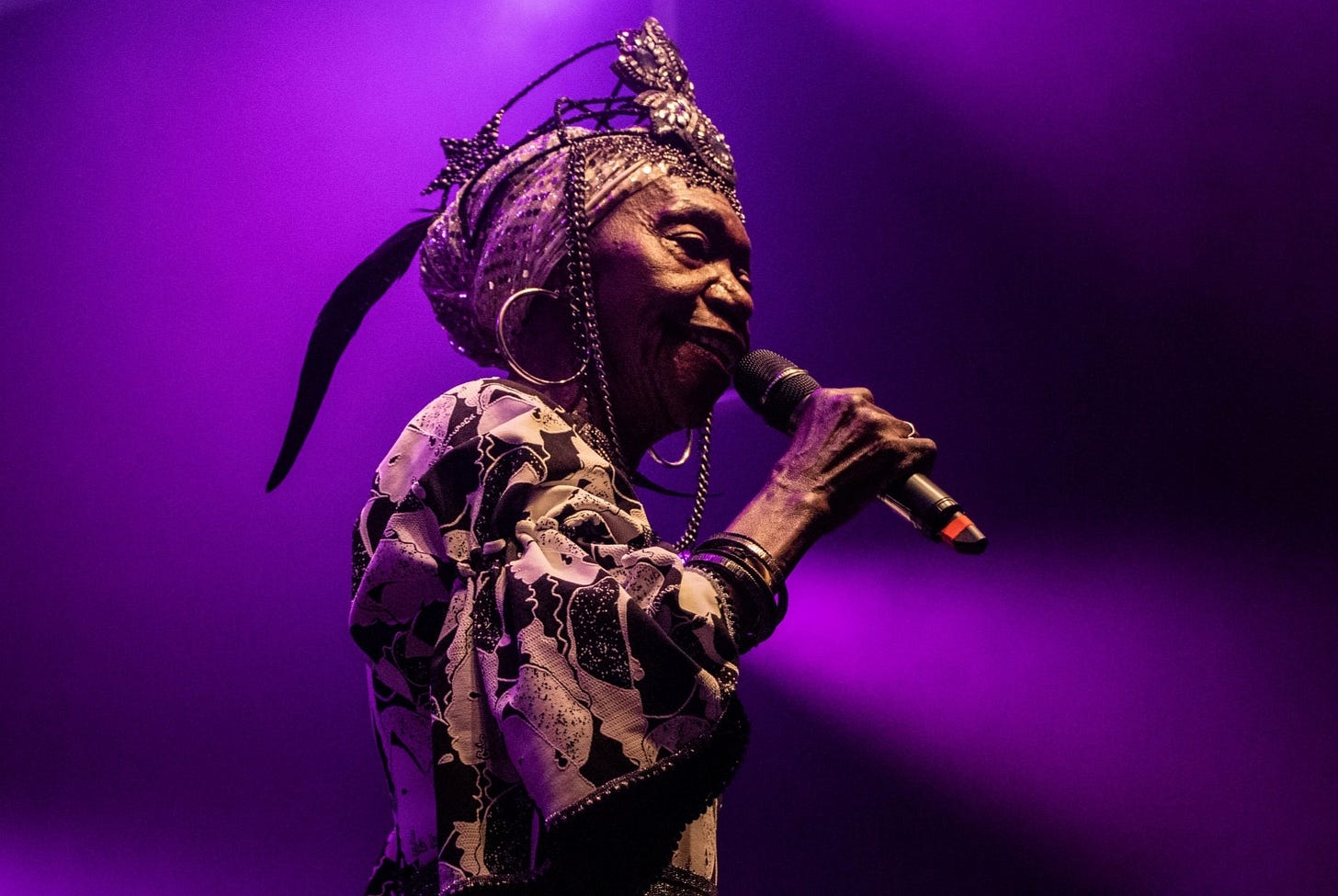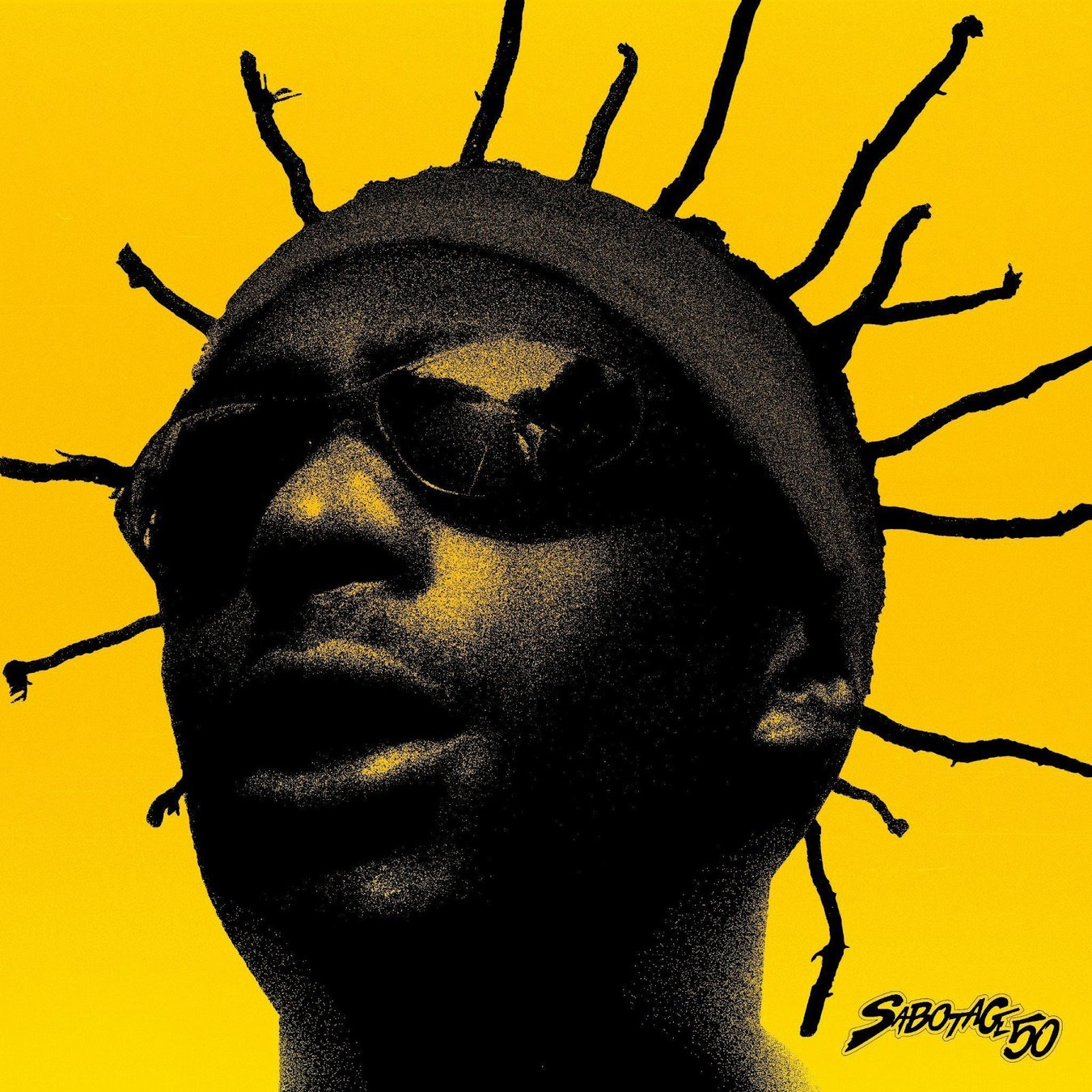Meia Volta #8: The Matriarch of Ciranda, Feeling Home at a Rio Vinyl Store, and The Eyes of Alcione
Painting a Fuller Picture of Brazilian Music
Salve, Brazilian music enthusiasts! ❤️
Co-editors Beatriz Miranda and Ted Somerville here. How’s it been on your end? Did you enjoy our latest edition?
Welcome to Issue #8 of Meia Volta, the first newsletter to present the nuances of Brazilian music they don’t tell you about 👌
In this issue…
An exclusive with ciranda matriarch Lia de Itamaracá; a new section about vinyl stores in Brazil; samba queen Alcione through the lenses of Anna Miranda, and more!
Before you peruse, just a quick reminder to check out and follow our Instagram account for excellent visuals and the latest and greatest in Brazilian music.
Bora lá? :)
BRAZILIAN MUSIC IN A PHOTO
Alcione by Anna Miranda
Anna Miranda is a 24 year-old photographer and artist from Rio de Janeiro. She currently works in the music industry shooting BTS visuals for music videos and shows as well as pursuing personal projects on the side.
“I began my artistic path with drawing, and later, while studying at journalism school, I discovered photography. It was the first contact I had with a professional camera, and from that day on, I never stopped taking photos.
Photographing Alcione was definitely one of those exceptionally emotional moments. I believe that the act of photographing carries with it a commitment to that photo, that specific moment. Photographing her is synonymous with portraying her strength, presence, and story. It's a strong photo. You don't need many elements in the photo when you have Alcione and a crown. The two together already says a lot in itself.”
Anna’s fave Alcione classic: “Não Deixe o Samba Morrer" (Don’t Let The Sama Die”)
Anna’s new music recommendation: Tasha & Tracie
“For anyone who wants to enter the ciranda, I will make space”
Q&A with Lia de Itamaracá.

“Ciranda” and “Lia de Itamaracá” are pretty much synonyms these days. Thanks to this singer and composer, Ciranda—a music and dance expression prominent at the seaside of Pernambuco State—gained nationwide acknowledgment. Now, it is recognized as a culture that is as traditional as contemporary. While Lia also owes her formation to other Brazilian music expressions—such as coco de roda and the rhythms from Catholic processions—ciranda is where her legacy points. Having recently turned 80, Lia owns the title of Living Heritage of Pernambuco and has already been honored by diverse contexts and people (from Rio’s world-famous carnival to American star, Jon Batiste).
Below is the edited version of our exclusive interview with the highness of ciranda:
Beatriz Miranda - Good evening! What a pleasure, what an honor…
Lia de Itamaracá - The pleasure is mine.
Meia Volta - How wonderful to talk to you! Thank you for taking the time to share a little of your story and your music with me today. I wanted to start by asking you about your first memories of life linked to music.
Lia de Itamaracá - Well, my first memory of music... I started when I was twelve years old. I was interested in music. At the age of nineteen, I took on the responsibility of singing, composing, recording, and getting deep into making songs.
MV—When you started participating in the ciranda scene, both on Itamaracá island and in other villages, it was still very much dominated by men. What was that like? Do you think it was difficult to gain space in the circle because you are a woman?
LI - No, it wasn't for me… It was everything I wanted to do and what I liked to do. Nothing was difficult for me. There were men… and there were a few women. But, today, I make space for anyone who wants to enter the ciranda scene. For those who want to learn something, I teach it.
MV - What inspires you to compose music?
LI - I am inspired by the waves of the ocean. My songs come from the beach and the shores. I write my songs on the beach. The wave comes, goes out, and I light up. The wave comes, goes out again, and I light up. When another wave returns, the music is ready—with the strength of Iemanjá and my talent.
MV - And what fascinates you most, what enchants you most about ciranda culture?
LI - What I love most are the fans. It's singing, pleasing the public. This is very important for me. I feel very happy.
MV - And what are the other genres of Brazilian music that you like, that interest you and that inspire you?
LI - Oh, there's the coco de roda, there's the pastoril, there's the fandango, which no longer exists. And carnival music. All of them inspire me and help me in my ciranda compositions, so they’re important to me.
MV - And do you remember any exchanges, any experiences with foreign musicians that were notable in your career?
LI - Working with Jon Batiste. I participated in his show in Rio de Janeiro, São Paulo, and at the Montreux Jazz Festival in Miami. I love working with him.
MV—At this year's carnival, two samba schools, one from Rio and one from São Paulo, paid homage to your work and legacy in Brazilian popular culture. How important is it to talk about the ciranda in these major carnivals in Rio and São Paulo since they have so much visibility and effect?
LI - Well, the honor of these two schools weighed a ton for me. I loved it! I paraded with both schools, Vila Matilde (São Paulo) and Império da Tijuca (Rio).
MV - At 80 years old, what are you most proud of in your career in Brazilian music?
LI - I'm proud of being happy. To delight the public, the fans. To have fulfilled my dream of being a singer.
MV - For 2024, do you have concert, recording, and composing projects?
LI - I have a show in São Paulo, and possibly a new tour in Europe in the second half of the year.
MV - Finally, have you been following artists from the new generation of popular music that you like and that you would recommend to readers?
LI – Isaar. This girl is sensational!
MV - Would you like to say anything else and leave a final message before concluding?
LI - A lot of faith and axé for everyone, especially for those of you who are taking me and my music to other places.
WHAT’S SPINNING
PRESENTING: MARACA DISCOS - PART I
In this issue, we are thrilled to release “What’s Spinning?”, a Meia Volta section that will present the soulful vinyl stores we come across (in Rio, São Paulo, and other Brazilian cities).

Starring in this section is Maraca Discos, a by-appointment vinyl store located in the Rio North Zone neighborhood of Maracanã - that’s right, the region where the namesake stadium is located ;)
I was introduced to Maraca by several acquaintances - people who don’t know each other but share an interest in vinyl collection and analog music listening. Maraca is run by Jeeni Andrade, Edgar Ramos, and Frida, their adorable dog.
Maraca has an intimate feel. The fact that it was projected in the garage of a 1960s house on a residential, wooded street, certainly contributes to this environment. But seeking your next vinyl while barefoot on its comfy artificial grass floor, the warmth of Frida, the charisma of the owners, and the way they host their clients - one-on-one, and on appointment only - are the key ingredients to the coziness of the Maraca experience.
While the vinyl store is a side job for Jeeni and Edgar (a martial arts teacher and a geography teacher, respectively), Maraca arose from their interest in making complementary income from their longstanding passion for vinyl.
“We were still in the pandemic and felt we needed to supplement our income. At the same time, we already had a big vinyl collection—big enough for us to open a store. We sat and discussed the project of Maraca Discos, which launched in 2021,” said Jeeni, who, influenced by a family of break-dancing parents, a rock-fan uncle, and the funk parties of the Complexo do Alemão favela community, grew up with an eclectic music taste.
What also makes Maraca Discos stand out is its particular attention to Brazilian music cultures that started consolidating their space in the contemporary vinyl market. Local pop genres like funk and rap have always been at the margins of what the so-called intellectual elite (the predominant audience of vinyl consumers) considers “good taste.” As they enter the sector, funk and rap end up pushing for a shift to a more democratic vinyl market mindset.
“Most vinyl consumers will still think that funk records are a waste of time. Investing in a funk or a rap vinyl is still rare,” said Edgar Ramos.
“We want to make sure we celebrate the presence of Brazilian funk in the vinyl culture,” said Jeeni, showing the recently released vinyl of Brazilian funk DJ, Ramon Sucesso, produced in the UK. “And we want to produce more vinyl of funk artists ourselves,” she concluded.
STAY TUNED FOR “MARACA DISCOS - PART II” IN AN UPCOMING ISSUES…
BRAZILIAN ALBUM REVIEW
Review by guest collaborator Felipe Arêas.
Felipe Arêas is a Brazilian, Rio-based record producer and mixing engineer constantly seeking new music to explore.
Moacir de Todos os Santos (2022) - Letieres Leite & Orkestra Rumpilezz
Paying adequate tribute to the Brazilian maestro, composer, and pianist Moacir Santos is a challenging task, to say the least. As the leader and founder of Orkestra Rumpilezz - which deserves a review of its own - musician Letieres Leite managed to reimagine the work of Santos in a way that conveys both originality and respect for the music to which it pays homage.
The state of Bahia is known for its musical connection with the Afro-Brazilian religion candomblé, an inherent characteristic of the Bahia-born Orkestra Rumpilezz. The unusual collective merges aspects of traditional big bands with regional percussion instruments such as the rum, which, aside from naming the group, is a drum originally used in candomblé religious practices. The way Rumpliezz achieves such a big sound with only wind and percussion instruments defies expectations - even the bass role is groovily played on a tuba.
Coisa Nº 8 highlights the above-mentioned contrast in a very interesting way: The strings are replaced with a mellow brass arrangement, while the classy vintage drums from Moacir's originals get reworked for the Candomblé drums. An interlude is added for more contrast while a new saxophone solo creates space for the groove to happen between the rhythmic section and the brass ensemble. It is amazing to see how Leite succeeds with brilliance in arranging both axé music/pop songs such as “Festa,” a major hit by Bahian pop singer Ivete Sangalo, and in reimagining Moacir Santos' work with elegance and originality. Though it is deeply sad that Leite left us in 2021, ‘Moacir de Todos os Santos’ is a joyful reminder of the wonderful music he made in his lifetime.
BRAZILIAN MUSIC NEWS
Some Brazilian music film releases in the past weeks:
“Lupicínio Rodrigues - Confissões de um sofredor” documents the life and career of Lupicínio Rodrigues, one of the outstanding names of the samba-canção music in the 1960s and 1970s.
“Nada Será Como Antes - A Música do Clube da Esquina” tells the story of the music group behind the album “Clube da Esquina” (1972), considered by several music critics the best Brazilian album of all time.
“Saudosa Maloca” is a fiction inspired by the life chronicles and work of Adoniran Barbosa, a reference musician when it comes to São Paulo’s samba history.
Also…
A commemorative album pays tribute to Sabotage, a notable and beloved São Paulo rapper who would have turned 50 last April 3rd.



